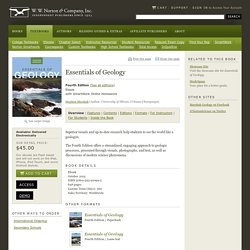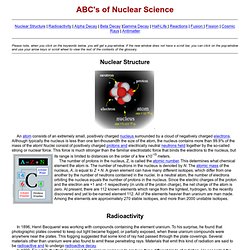

Essentials of Geology. Fourth Edition (See all editions) Ebook with SmartWork Online Homework Stephen Marshak (Author, University of Illinois, Urbana-Champaign) Superior visuals and up-to-date research help students to see the world like a geologist.

The Fourth Edition offers a streamlined, engaging approach to geologic processes, presented through visuals, photographs, and text, as well as discussions of modern science phenomena. Book Details Ebook October 2012 ISBN 978-0-393-91099-5 648 pages License Term (days): 360 Sales Territory: Worldwide Other Formats.
Fire and Ice. Volcano research in Central America. Professor Hazel Rymer, Open University What really fascinates me about volcanoes is you can go up to the top of a volcano and look down into this enormous hole that’s been made by nature; people haven’t had anything to do with it.

And whatever we do in terms of trying to monitor volcanoes, trying to understand how they work and all that sort of thing, and trying to, we can mitigate against some of the effects of them, but there’s absolutely nothing we can do to stop a volcano erupting. And I rather like that because it just reminds us how small we are on this planet. For a long time, we’ve been working in at two volcanoes: Poás and Masaya. One’s in and one’s in . Volcanoes aren’t really the best places to conserve anything. So what we’re doing is looking at the impact on the natural environment, we’re making measurements on the soils and so on, to see how that varies in comparison with a region, you know, in the same country, but not impacted by the volcano.
Plate Tectonics - OpenLearn - Open University - S279_1. Why do volcanoes erupt? The main factor controlling the nature of an explosive eruption is the viscosity of the magma.

If viscosity is low, vesicles may coalesce as they rise and merge into large bubbles a metre or more across before reaching the top of the conduit. These arrive at irregular intervals and on bursting throw out a shower of ejecta. If the bubble bursts gently, the ejecta flops out around the rim of the conduit. Strombolian activity More violent bubble bursting throws ejecta to greater heights, and this sort of episodic activity is described as strombolian, after the active Mediterranean volcano Stromboli. Sometimes the expansion of vesicles in a basaltic conduit can cause magma and bubbles to accelerate upwards together, forcing them out of the vent at speeds of the order of 100ms−1 as a fountain of incandescent lava,graphically described as a fire fountain. Creative commons image Credit: Sabrian.MILLOT 8 via Flickr Stromboli [Image: sabrina.MILLOT. Fire and Ice. Periodic Table of Elements: Los Alamos National Laboratory.
FAQ: Atoms, elements, and ions: How does a mass spectrometer separate isotopes? Basic Nuclear Science Information. Nuclear Structure | Radioactivity | Alpha Decay | Beta Decay |Gamma Decay | Half-Life | Reactions | Fusion | Fission | Cosmic Rays | Antimatter Nuclear Structure .

An {*style:<a href='javascript:windowOpener('Glossary.html#Atom',%20'glossary');'>*}atom consists of an extremely small, positively charged {*style:<a href='javascript:windowOpener('Glossary.html#Nucleus',%20'glossary');'>*}nucleus surrounded by a cloud of negatively charged {*style:<a href='javascript:windowOpener('Glossary.html#Electron',%20'glossary');'>*}electrons.
Although typically the nucleus is less than one ten-thousandth the size of the atom, the nucleus contains more than 99.9% of the mass of the atom! Nuclei consist of positively charged {*style:<a href='javascript:windowOpener('Glossary.html#Proton',%20'glossary');'>*}protons and electrically neutral {*style:<a href='javascript:windowOpener('Glossary.html#Neutron',%20'glossary');'>*}neutrons held together by the so-called strong or nuclear force. Dating: Absolute Dating. Absolute dating can be achieved through the use of historical records and through the analysis of biological and geological patterns resulting from annual climatic variations, such as tree rings (dendrochronology) and varve analysis.

After 1950, the physical sciences contributed a number of absolute dating techniques that had a revolutionary effect on archaeology and geology. These techniques are based upon the measurement of radioactive processes (radiocarbon; potassium-argon, uranium-lead, thorium-lead, etc.; fission track; thermoluminescence; optically stimulated luminescence; and electron-spin resonance), chemical processes (amino-acid racemization and obsidian hydration), and the magnetic properties of igneous material, baked clay, and sedimentary deposits (paleomagnetism). Other techniques are occasionally useful, for example, historical or iconographic references to datable astronomical events such as solar eclipses (archaeoastronomy). Wiki - Using Radiometric Dating to Determine the Age of Rocks and Minerals. Wiki - Using Radiometric Dating to Determine the Age of Rocks and Minerals.
Wiki - Using Radiometric Dating to Determine the Age of Rocks and Minerals.